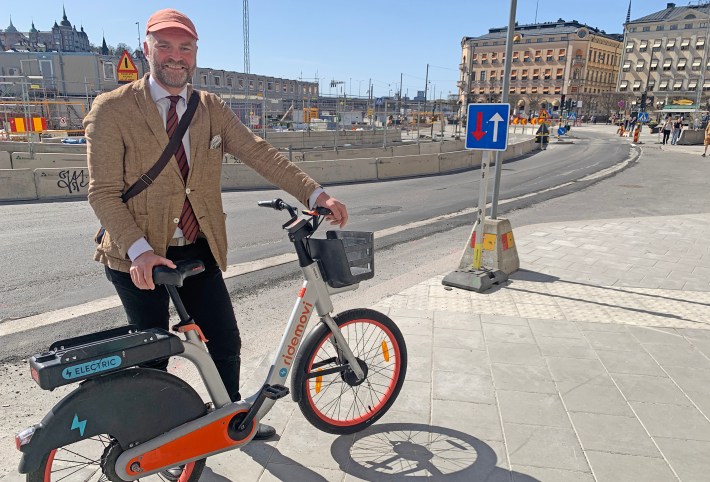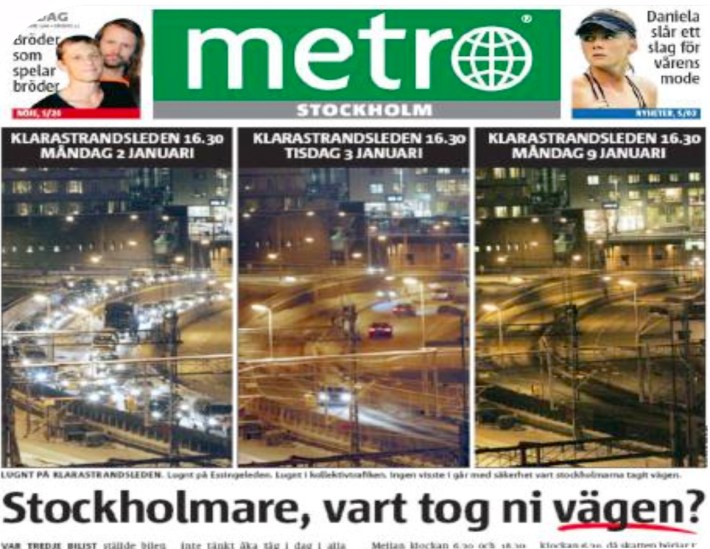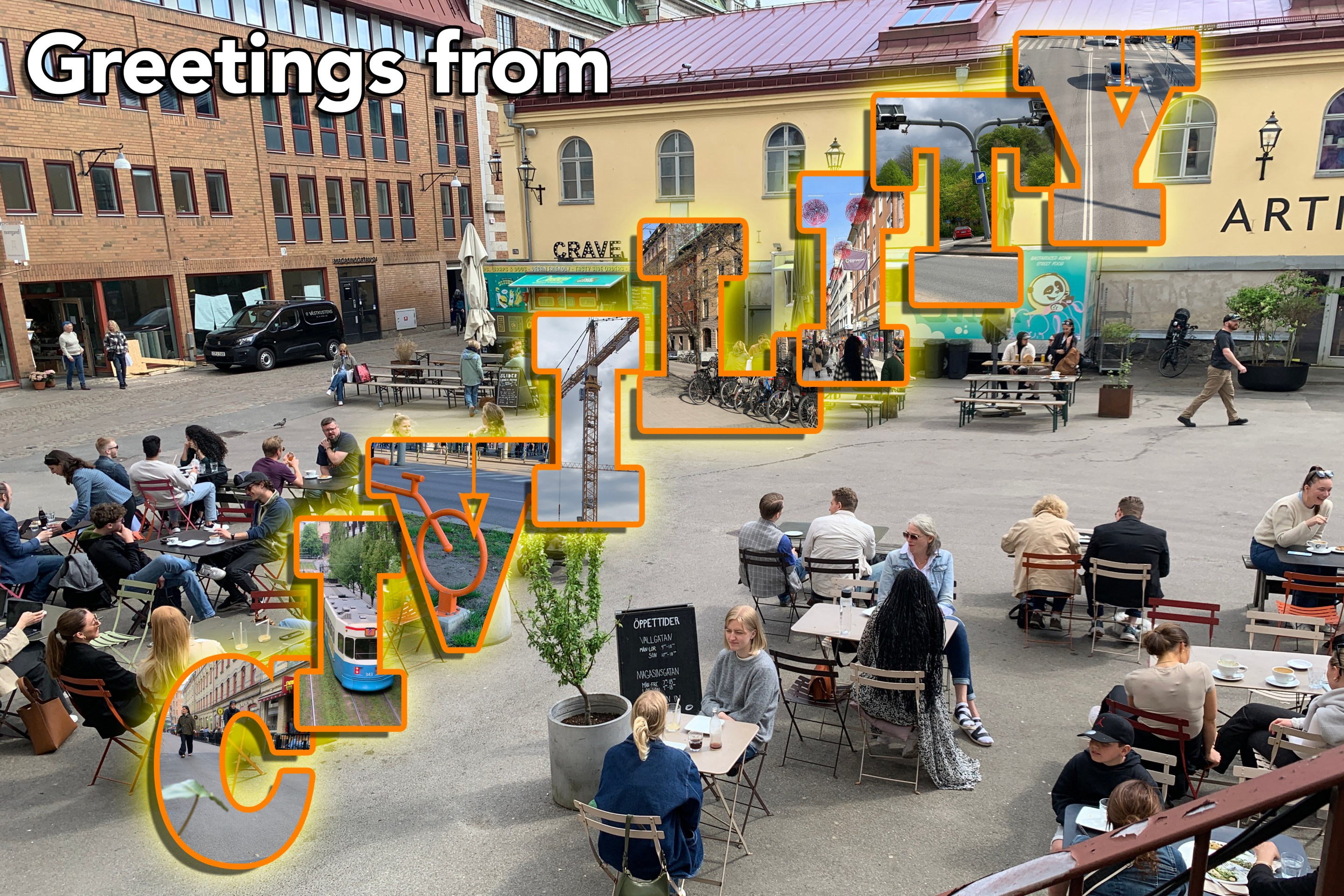This is the third (and final?) article in a series of pieces written from Sweden, where Streetsblog Editor Gersh Kuntzman is studying congestion pricing, which has existed in Stockholm since 2007 and Gothenburg since 2015. To read the entire series, click here.
STOCKHOLM — Swedes think we’re nuts.
In conversation after conversation I've had in the Swedish capital and in the western city of Gothenburg, Swedish bureaucrats, shopkeepers, cyclists and even drivers were aghast to hear that a majority of New York-area residents oppose congestion pricing as it is about to be implemented. In Sweden, you see, the congestion charges work so well that many residents don’t even remember how controversial it was when they launched it themselves.
Younger residents, that is. Older Swedes certainly recall the bitter debates before their version of congestion pricing was proposed in the mid-2000s. At that time, drivers could not accept that they would be forced to pay for something that had always been free (for them, at least). But the success of the policy — double-digit percentage declines in traffic, money reinvested in road redesigns and transit, fewer crashes, better air quality — made the controversy evaporate like the congestion it dissipated.
“People finally understood that there is no such thing as a free lunch, especially not in a city because you want to create value for as many people as possible with the limited space you have,” Lars Strömgren, Stockholm’s vice mayor for transportation and the environment, told me. "Some people need to drive, but sitting in traffic is not free, either. Those hours, they cost everyone. So this was a way to create the more efficient usage of the transportation system.”
Strömgren suggested that the loudest voices against the congestion charge will, if they are willing to be honest, be its greatest beneficiaries.

“Their drives will be faster, but they will also have an incentive to try other modes of transport, like the subway, the tram or the bus or the bike.”
Cycling is indeed soaring in Stockholm and in Gothenburg, the other Swedish city with a charge to enter the urban core. On a nice day, 32 percent of all commuting trips in the capital are made on a bike. That’s up from 1 percent in the 1980s, and it’s partly the result of investments in street redesigns funded by the congestion charge, Strömgren said.
“We needed to change the transportation system because one person in each car is not a very efficient use of space, and a city needs efficient use of public space,” he added.
Or, as Carl Molinder, who sells cargo bikes for the Swedish company Lovelo, put it, “All the political parties, even the conservatives, realized they had to reduce congestion, which was choking Stockholm. And once they did it, the controversy ended immediately."
The beginnings
Swedish politicians started talking about congestion pricing in the early 2000s, but did not implement it until Jan. 3, 2006 — and only then for a six-month trial. The Swedish Road Administration, Vägverket, claimed that traffic passing in and out of the congestion zone dropped by between 20 and 25 percent during the period of the trial, and that air quality improved.
That's why a majority of Stockholmers voted "yes" in a subsequent referendum, though a majority of residents of the suburbs voted "no." To partly assuage the drivers' anger, the initial congestion tax was set aside to finance construction of a new bypass highway. Once that was done, the fee was raised slightly in 2016 and the money was set aside for transit improvements.
Stockholm's toll is dynamic, meaning it changes all day to reflect peak and off-peak demand periods. But even so, during the trial, it only reached a maximum of $2, and there was no charge during nights and weekends, yet the city quickly raised roughly $40 million. Unlike New York's flat $15 fee from 5 a.m. to 9 p.m., the smaller congestion tax in Stockholm and Gothenburg is applied on both entry and exit of the affected area.
Stockholm officials learned a lot from the trial: Transit use soared and traffic was reduced by more than anticipated. The same media outlets that condemned the toll — what's Swedish for "New York Post"? — were suddenly championing it:

Months after the referendum, support was even higher for the improvement, according to the local media.
"People saw the results so quickly they couldn’t say it wasn’t working," said Anders Sundström, the recently retired reporter from Dagens Nyheter. "And then they added pedestrian zones, which are great for business. And more bike lanes. The goal was to change people's habits, and it worked."
Habits are important to break because, by definition, a habit is something you do without thinking — which is never a good idea, Sundström mused. In the case of cars, the habit is to simply use the gas-burner for every trip, even if a bike or a bus makes more sense.
Another Stockholm figure put it another way — car driving is like being offered free candy in a shop.
"If the candy is free, you'll take way more than you need or even want," said Jonas Eliasson, one of the architects of Stockholm's system. "But if the candy is 10 cents per piece, you will actually think, 'How many pieces do I want? Maybe it's four or five.' But it's not really about the money. It's just being forced to make a conscious decision of what is worth it for you in that moment."
He said that very few people got rid of a car, but that Stockholmers just made one-fifth fewer trips into the most congested part of the region in their cars. They still take their cars to their country homes; the only difference with New Yorkers? The Stockholmers with second homes whom I met know they're privileged ... and act with appropriate humility.
Another difference
Swedes really think we're crazy not only because so many New Yorkers obstruct or cover their plates to avoid our existing speed and red-light cameras, but that so many of them are cops! I must have shown this video to 20 people, and the reactions included hysterics, mouth-agape astonishment and outrage:
At was a beautiful day in Williamsburg today, so I figured I'd help out a cop who scratched off most of the numbers on his plate. I would hate to see one of @nypdpc's officers get a ticket for defacing his plate. pic.twitter.com/eQf8ULzjNH
— Gersh Kuntzman (@GershKuntzman) March 4, 2024
In reality, an official with the Swedish Transport Administration told me that in the first few months of Gothenburg's congestion tax, some people did indeed cover their plates. But in the 10 years since, such criminal mischief is virtually non-existent.
How non-existent? With a few mouse clicks, Jörgen Andersson, a systems administrator at the Swedish Transport Agency (a different part of the government), was able to look up how many "manipulated" plates had passed through cameras in the city of Gothenburg on a given day.
It was just three out of 46,000 — or 0.006 percent. By comparison, the number of unreadable plates in New York City soared at one point to more than 7 percent, according to the city DOT.
Live from Stockholm! It's #CriminalMischief: Sweden. Will I be able to find a plate defacing perp? Join me. pic.twitter.com/pVUsC01QQd
— Gersh Kuntzman (@GershKuntzman) May 1, 2024
Andersson's colleague Jonny Geidne was stunned by New York's criminal numbers. "We don't do that kind of thing to our plates because it's just so obvious," he said.
"Obvious? To whom?" I asked.
"To everyone!" Geidne said. "There is a great deal of social stigma about law-breaking here."
And Viktor Hultgren, a city planner in Gothenburg, suspected that people don't want to cheat the authorities because, unlike New Yorkers with a car, they don't feel that a toll that funds transit or a speed camera that catches law-breakers are a "revenue grab."
"We just have a higher level of trust in government, I suppose," he said over a lunch of cod topped with horseradish and hard-boiled eggs that was so odd that it made me question my trust in Swedish culinary talent).
I suggested to Andersson that Americans simply reject out of hand any effort by the government to change bad habits. He agreed that such change is easier in Sweden.
"The congestion charge in Stockholm was designed like any tax — as a way to encourage people to change their behavior away from something bad, like smoking or drinking, towards something better, like taking transit," he said.
His colleague Geidne jumped in: "The kind of resentment you're talking about is stronger in the U.S. than it is here."
In fairness to our level of resentment, I reminded many Swedes that New York has done not nearly enough in advance of the implementation of the tolls. In Gothenburg, for example, the government built 56 miles of new bus lanes, added new bike lanes, expanded the train capacity on platforms and with 34 new trains, added more bus rapid transit, expanded park-and-ride and created a bike share system — all before the congestion charge began.

In addition, both Gothenburg and Stockholm use time-based fees, so that drivers can make adjustments to save a little money — say, by entering the city in lower-traffic periods.
"Congestion pricing should be about changing when and how people travel around, which is why we favor different tolls at different times," said Per Bergström-Jonsson, a Swedish environmental official and consultant who implemented the congestion pricing charge in this city of 500,000 a decade ago.
This sounds familiar...
Many Swedes to whom I spoke complained that congestion pricing is a tax on the poor and people of color. But, just as in New York, the people making that argument are often wealthy white people.
"I always found it funny who makes the argument that working people 'need' a car," said Andersson. "They always use the example of the single mother with three children — and it's always a middle-aged white man saying it, because he wants to protect his right to use an SUV in the city. So, I mean, that's quite silly."
Just as in New York, the vast majority of Stockholm commuters take transit to get to work (and since the congestion charge went in, cycling is booming, as I might have mentioned). But when you bring up facts to many New Yorkers — such as the fact that only 2 percent of outer-borough residents in poverty commute by car into the Central Business District — there is widespread disbelief.
"Working people need cars to get to Manhattan," a friend of mine, who is too smart to be that dumb, told me the other day. "How about the tradesman who lives on the Lower East Side and has to drive to his job every day? Now he's $15 poorer every day. Maybe he'll finally throw in the towel and move." (Or, I retorted, just pass the $15 charge along to his multiple wealthy Manhattan customers every day.)
In Stockholm residents seem to be able to grasp the basic truth of urban mobility. Or, as Sundström, the retired reporter, put it: "The equity argument is total bullshit. Poorer people take transit. It’s the wealthy who say that the poor drive. Come on, gas is so expensive here, compared to in the States, so you're already subsidizing driving. And parking is so expensive. Transit is cheaper than all that."
But that "equity" argument is persuasive, added Gothenburg political scientist Sverker Carlsson Jagers, who has done extensive polling on congestion pricing.
"Perceived unfairness is important even if the perception is inaccurate," he said. "In Gothenburg, which did not have a referendum, the congestion tax remains less popular because there are a lot of members of the public who feel that it was stuffed down their throats. But unlike in New York, that anger is neutralized a bit by the fact that our fees are lower during off-peak periods. It gives drivers a way to not pay as much, simply by changing their timing. It's more freedom of choice."
The Gothenburg experience offers some of the warning signs for New York. Like then-Gov. Cuomo pushing congestion pricing to raise $15 billion for the subway, Gothenburg only undertook the congestion charge to raise revenue for some major infrastructure projects that the Swedish federal government didn't want to full fund.
"The city basically admitted it needed the money, and that pissed people off," Bergström-Jonsson. "Doing it for the revenue is political dynamite."
Eliasson made a similar point in this Streetfilm video when I chatted with him in Stockholm:






